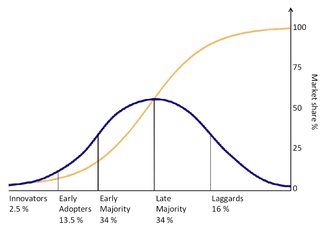Top 5 Perceived Attributes of Innovations and Their Effect on Rate of Adoption


Before jumping into the attributes of innovations, we need to understand the context and best means of leveraging their strengths. Attributes or properties are forms of evidence meant to demonstrate to members of each adopter category the value of our innovation to them as individuals. Adopter categories refer to the buyer’s personality and how they align on the adoption curve; what maturity and tangible strength levels of evidence they require to buy?
Once we understand the relative strength levels needed, we then move to the perceived attributes or properties of the innovation at a personal level.
#1. Relative advantage: the degree to which an innovation is perceived as better than the idea it supersedes. The advantage can be expressed in many ways ranging in profitability, time, usability, social prestige. No matter how defined, the innovation needs to be perceived, offering a big reward for adopting the new solution.
The issue is to get the person to change from what they have and are comfortable with to some new unknown solution. Getting a person to change is hard. They need a good reason to do so. So the perceived attribute needs to offer a substantial reward for doing so. While all five attributes have a place, relative advantage ranks above all others. Relative advantage is one of the strongest predictors of an innovation’s rate of adoption.
#2. Compatibility: Consistent with existing values, past experiences, and needs of potential adopters. Relative advantage is about comparing value propositions, usually as a ratio between current solutions and the new. Compatibility is about answering the questions –
- Is it aligned with deeply embedded cultural values?
- Does the solution generally make sense to me based on my experience?
- Does it match well with a critical need?
Naming is another element of compatibility, and we can’t say enough about the importance of naming in the rate of adoption.
#3. Complexity: The degree to which the innovation is perceived as relatively difficult to understand and use. How easy is it to introduce into current processes? Will it require new skills, tools, or training? Your innovation needs to consider the implications on the customer to deliver maximum value and minimize any barriers to entry.
If your innovation requires changes in the process flow, retraining of the workforce, and adding time to the overall process, you have a problem. People who buy must perceive your innovation as elegant with little or no ‘shadow costs’ within the grand scheme.
#4. Trialability: The degree to which the innovation may be experimented with on a limited basis. Trials are significant in the early stages of adoption.
For example, if the solution goes against the adopter’s experience or can’t see how the innovation can achieve the advertised result, trials and demonstrations will be essential. The customer needs to mitigate risk, and lacking evidence such as well-established references, seeing is believing. But importance will diminish over time with the development of hard evidence and reference accounts.
#5. Observability: How easy is it to observe, understand and communicate the results to others? Observability is all about ‘getting it.’ How quickly/easily can the market perceive the relative advantage, value at a glance? Will the customer go “wow” when they observe the innovation? How easily can the observer describe the value proposition?
How excited and articulate will the person be when they relate the value in their words to their peers and leadership. The more observable the results the, less need for trials and the faster the rate of adoption.
Conclusion:
The adopter categories and the 5 perceived attributes of innovation are an integral part of success.
Every point is connected and receives value from those preceding it, and it adds value to those that follow on. The adopter categories tell us the type of buyer we are dealing with, the type of evidence they will require to buy, and the attributes of innovation explain how to frame and present our story and the supporting evidence—all while using the vocabulary of the market.
But that’s not all. The positioning, messaging, branding, and marketing materials mature with the evidence path defined by the process pretty well, but there is more. The business model for growth needs to be expanding, as an example, but the one area that seems to get missed is that the sales approach is different. Remember when we asked the visionary and the early adopters to use their imagination to fill in the missing parts to complete the innovation vision?
Having a discussion involving imagination and vision takes creativity and the skills to convey the concept. It worked great at the far left of the adoption curve, but when you knock on the door to enter the early majority, things will differ; this is not the approach for early majority success.
The early majority adopter is not looking for creativity. They expect hard-supported facts and someone with the skills to deal with their questions and objections. These adopters expect a whole solution that makes buying easy.
Continually improving and documenting your relative advantage and relevance to a significant customer problem are two of the most important characteristics affecting adoption rates. Simply because the more we move along the adoption curve, the audience becomes more and more pragmatic, therefore, requiring more evidence. So, the faster we can build a strong base of personalized evidence and referrals, the quicker the adoption rate.
For a bit more on the subject, we have a short white paper, Why the Best Products Fail Click Here

